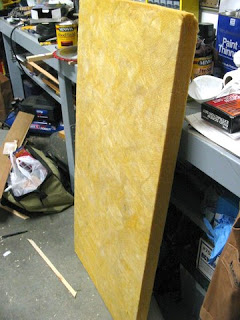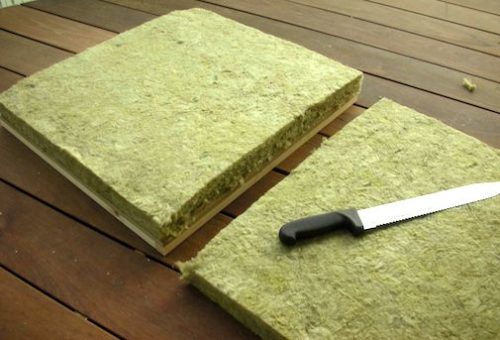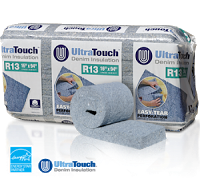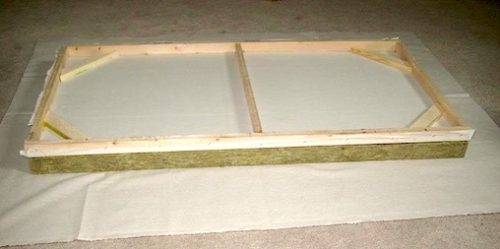- in Acoustics by Bobby Owsinski
How To Find Cheap Acoustic Panel Materials
I posted this few years ago on my other blog, but the question keeps popping up so here’s an updated version. Where do you find acoustic panel materials (like Owens Corning 703) so you can build your own panels? At one time, most of the excellent acoustic panel materials weren’t found at your local Home Depot, but that’s changed a bit recently. Here’s an excerpt from The Studio Builder’s Handbook that covers what materials are available and where to find them.
Owens Corning 703

Owens Corning 703 panel
Acoustic panels can be made from a few different materials, some more effective than others. The difference in materials is not only the amount of absorption, but the absorption ability at different frequencies. The standard for acoustic panels and general acoustic absorption for decades has been Owens Corning 703, which you won’t normally find at Home Depot (see the graphic on the left).
Instead, look for a local supplier of “Industrial Insulation,” or an HVAC supplier, who should normally carry it. When asking for it at a specialty supplier, sometimes it’s called “industrial furnace insulation board.” You can also find it online at a number of places including readyacoustics.com and gikacoustics.com among others.
703 costs approximately $12 a panel (sometimes more and sometimes less, depending on where you buy it) and comes in packs of six. Knauf ECOSE, Johns Manville, and Certainteed are the same kind of ridged fiberglass, and can be even cheaper than their Owens Corning equivalent. Just be sure that the thickness and density is the same. Try buyinsulationproducts.com.
Handling fiberglass can irritate your skin, eyes and respiratory tract, and the dust particles are so small that they can get trapped in the lungs and become carcinogenic in some people. That’s why it’s important to always wear gloves and a mask when handling it.
Mineral Wool

Roxul Rockboard being cut
Mineral wool is another mineral fiber insulation product that works as a 703 or R 13 alternative. It’s a lot less expensive than 703, and even has better absorption characteristics, but it can be a little harder to work with because it’s not as rigid.
Try Roxul Rockwool RWA45, RW3 or the ridged Rockboard 60, which costs about $35 for a package of 6 panels (see the figure on the left). Today you can find Roxul Safe ‘n’ Sound at your local Home Depot or Lowes, or try online at atsacoustics.com, among other places.
Mineral wool is easily handled and does not cause any irritation to the skin, eyes or respiratory system like fiberglass does, yet it has about the same acoustic properties. That’s why it’s the preferred way to go if you can find it.
Ultratouch Cotton

Ultratouch Cotten
Yet another alternative is Ultratouch cotton, which is basically recycled blue jeans. You can now find it at Lowes or Home Depot. It’s about the same cost as rockwool and works almost as well, yet has none of the irritant properties of fiberglass. You can also use it in place of R 13 or R 19 in your walls. It can also be found at sensiblesolutions.com online. What’s interesting about this material is that it’s basically recycled denim blue jeans.
Foam Padding
If you’re really on a budget, foam carpet padding that can be purchased at any carpet store can be used an alternative to 703 or Rockwool. A 6 foot by 50 yard roll of half-inch foam carpet padding costs about $60, while a name brand acoustic foam of this size would cost well over $1,000. The foam sheeting is not as pretty as the professional name brand acoustic panels, but it works very well to reduce or diminish unwanted ambiance and you won’t tell the difference once covered with fabric. Be aware that you’ll have to use at least a couple of layers and the absorption still won’t be as good as 703 or Rockwool under 1kHz.
Frames

Acoustic Panel frame
The wood trim can be standard wall molding that can be purchased quite easily at any hardware store or big-box discount hardware store. Typically hardwood molding can be very expensive and run from $8 to $40 and up per linear foot, but try high quality pine molding, which is both affordable and looks fantastic once it’s lacquered.Frames for acoustic panels can be made using 2 inch by 2 inch wood and then covering them with cloth to give them a very pleasant appearance (see the graphic on the left). This doesn’t have to be an expensive wood (pine will work), as it can be stained, covered with a wood trim or just covered with fabric.
You can rent a pneumatic air hammer at your local tool and building supply company for not much money on a daily rental. If you use this nail gun with very small one inch finish nails to attach the trim to the wall panels, you’ll have a very nice look on your finished work.
Fabric
Covering acoustic panel materials is pretty easy in that all you need is a material that easily passes audio. This can be almost anything from burlap (probably the cheapest) to even speaker grill cloth.
The best way to test it is to blow into it, and if you feel your breath coming through the other side, it should work.
Maybe the most expensive covering is by Guilford of Maine, but it has the advantages of being acoustically transparent and flame retardant as well as being available in a wide variety of colors. You can find it online at soundaway.com, acousticalsolutions.com, noisecontrolproducts.com, as well as many others.
All that being said, cloth is available in many thicknesses and densities and there should be lots of local outlets in your area where you can purchase it at a discount. Sometimes it works better if you have thinner cloth that’s wrapped several times for a few more layers.
Try doing a test panel first to see how the cloth will work for you. You may find it best to use the thinner more affordable cloth even though you probably will have to take the extra time to attach multiple layers.
Finish materials
There are many places you’ll find locally where you can buy paint, wallpaper, and other finishing materials. Again, the big-box discount stores will offer you a very competitive and reasonable price, but don’t hesitate to check around with some of your smaller local stores. You may actually find a better selection as well as a very competitive price.
As you can see, it’s a lot easier to find acoustic panel materials that it once was, and the whole process can be pretty inexpensive if you know how to swing a hammer.
You can read more from The Studio Builders Handbook and my other books on the excerpt section of bobbyowsinski.com. Also, there’s more to learn about the Guitar Center Bankruptcy 2018.
